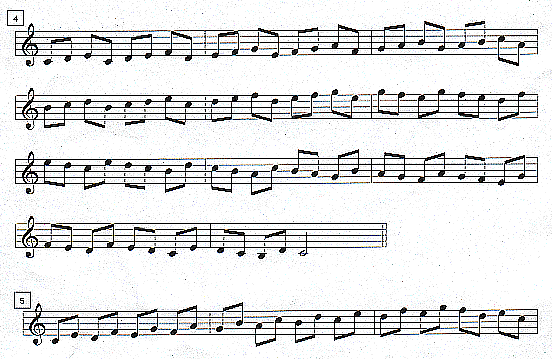Whether you're one of those guitar players who hates to practice scales or who loves to practice scales, you can do these same exercises on little scalar sections of your music just as well as on any scale. Take a difficult section from a piece of music that you are learning, writing, or improvising. Pay attention to every part -- the tone, speed, and evenness, using the techniques below until it is "happenning." Then take similar scales and work them into other parts of your music as well.
The very first step is to listen to the tone each individual note. Practicing speed is useless if the basic sound coming out of your instrument is like rubber bands or nails dropping into a bucket. Listen carefully to hear that each note is clear, and to minimize 1) separation between the notes, 2) the click of the fingernail against the string, and 3) extraneous noises.
Scales can be used to improve your right hand technique in general. Here are some suggestions to work on, whether you are playing with your fingers or a pick:
Position your hand so that your fingers are hanging over a given string, at a relaxed angle (fingers almost straight, perpendicular to the string). Play each note very slowly, alternating the index and middle fingers, watching the hand to be sure that each finger to falls back to position after each stroke.
Your fingers will only fall back to position if your hand is relaxed. If your hand is tense, it will take an extra motion to pull the finger back to position. Each stroke moves mostly from the big knuckle, stroking across the string instead of plucking up into the palm of the hand. Allowing only a very slight bend (at most) in the first two joints. Each stroke needs to strike across the string quickly, without allowing the finger to rest on the string.
This will allow the notes to ring longer and reduce separation between notes. Very slow and concentrated practice on hand relaxation between notes can work to eventually greatly improve the speed and fluidity of your music. Try this also with other sets of fingers: middle and ring, index and ring, thumb and index.
Relax the hand so that there is just enough tension to hold the pick. Don't worry if it drops out of your hand a couple of times while you are finding that balancing point. An angle slightly to the left will make the notes come out fatter, straight up and down gives a brighter sound. Alternate with down-up strokes. Then play the scale reversed, with up-down strokes. This makes for very rhythmic playing. At high speeds with a more legato sound, try using two down strokes or two up strokes when going from one string to the next.
This is the single best exercise to develop speed. By breaking up the scales to "long-short" and then "short-long" you are playing every other note as quickly and cleanly as possible, yet giving yourself time to think and listen to the sound of each note. It is important to work both patterns to practice quick finger motion between each pair of fingers. In the first exercise, try to make the time between the second and third notes as short as possible while you can take as long as you like between the first and second notes.

Then reverse, try to make the time between the first and second notes as short as possible.

It is important to have control of the volume of all the notes of the scale. Practice accenting every third note. Use a metronome to be sure that all the notes are at the same tempo. To really take control of your scales, practice accenting every 4th note, then every 5th note, every 6th note, and finally, every 7th note. You will find your speed improving when you concentrate your efforts on groups of notes in this way.

Here are some common patterns that can be used instead of just going up and down the scales (patterns in 3rds, etc.)

Composer and award winning guitarist Muriel Anderson has released seven CD's in the US, three in Japan, several books and videos, and is host and originator of the renowned "Muriel Anderson's All Star Guitar Night." Her "Heartstrings" album traveled as far as outer space, accompanying the astronauts on a space shuttle mission.
Muriel is co-author of the new book "All Scales In All Positions" (Hal Leonard Publ.)